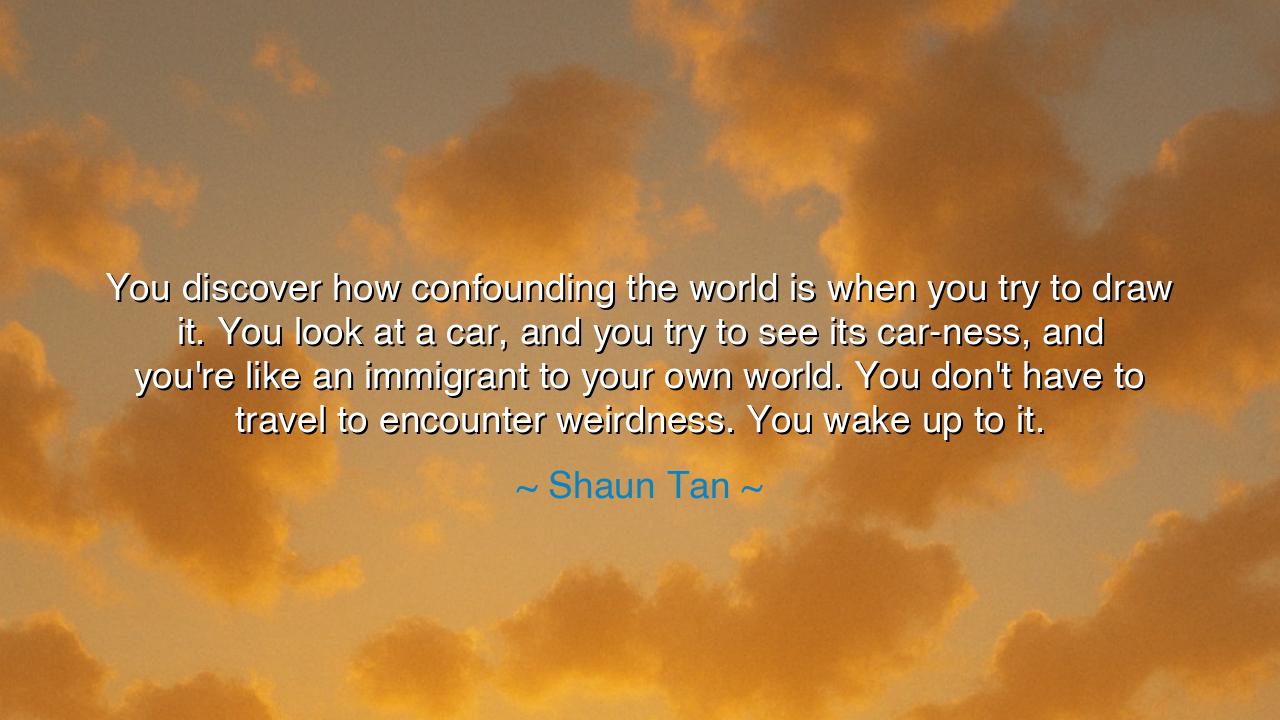
You discover how confounding the world is when you try to draw
You discover how confounding the world is when you try to draw it. You look at a car, and you try to see its car-ness, and you're like an immigrant to your own world. You don't have to travel to encounter weirdness. You wake up to it.






Hear now the words of Shaun Tan, dreamer and painter of impossible worlds: “You discover how confounding the world is when you try to draw it. You look at a car, and you try to see its car-ness, and you’re like an immigrant to your own world. You don’t have to travel to encounter weirdness. You wake up to it.” In this utterance he reveals a truth of profound depth—that the strangeness of life does not lie hidden in faraway places but dwells in the very objects we see daily, if only we pause to behold them with new eyes.
At the heart of this saying lies the idea of perception and estrangement. When we attempt to capture reality—whether with pen, brush, or word—we realize how little we truly understand it. To “see a car” as Tan describes is to suddenly confront its essence, its “car-ness,” as if we were strangers looking upon it for the first time. In this moment, the familiar becomes foreign, and the ordinary reveals itself as mysterious. This is the artist’s journey: to become an exile in one’s own world so that vision may be renewed.
This wisdom echoes through the ages. The ancient philosopher Heraclitus declared, “Nature loves to hide.” What he meant is that the truth of things is veiled beneath habit and assumption, and only those who look deeply—through wonder or through art—uncover it. Likewise, Tan teaches that through the act of drawing, through the effort of seeing with precision, we realize how uncanny the world truly is. To wake each morning and see the everyday anew is to be reborn continually into mystery.
Consider the story of Paul Cézanne, who painted apples so obsessively that he revealed their strangeness. To the casual eye, an apple is simple, but Cézanne showed that its curves, colors, and shadows could never be fully captured, that its reality always escaped representation. In his devotion, he was like Tan’s “immigrant,” foreign even to fruit he had held all his life. From this estrangement came greatness, for his apples shook the very foundations of modern art.
Tan also reminds us that one does not need travel to discover the bizarre. In a world obsessed with seeking wonder abroad, he proclaims that wonder already saturates the ordinary. The strangeness of existence dwells in the shape of a chair, the flicker of light on glass, the hum of a refrigerator. To truly see is to discover that the familiar is a mask, and behind it lies a world both bewildering and beautiful. The journey outward may bring marvels, but the deeper pilgrimage is inward, into the perception of what surrounds us each day.
There is in his words also a quiet challenge: to awaken. Most drift through their days half-asleep, numbed by routine, blind to the marvel of being alive at all. But the artist, the thinker, the dreamer—these are those who shake off the dullness of habit and confront the world as if for the first time. To live in this way is to live always in awe, to discover in every object the trace of the infinite.
The lesson, then, is this: train yourself to see the world as if you were a stranger within it. Do not let familiarity dull your vision. Look at the objects around you—the trees, the houses, even your own hands—as if they were miracles just arrived from another planet. In practice, this means slowing down, observing closely, sketching, writing, or reflecting upon the smallest details. By doing so, you will awaken to the truth Tan describes: that life itself is a perpetual encounter with wonder, that every morning is a journey into strangeness.
Thus, Shaun Tan’s words endure as a teaching for generations: you need not voyage to distant lands to find marvels, for weirdness is woven into the fabric of the everyday. The task is not to seek new worlds, but to learn to see this one with eyes unclouded. And in that vision lies both humility and joy, for when the familiar becomes strange, we remember once more that we are alive, standing in the midst of an unfathomable miracle.






AAdministratorAdministrator
Welcome, honored guests. Please leave a comment, we will respond soon